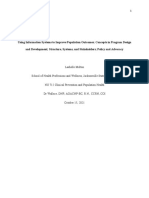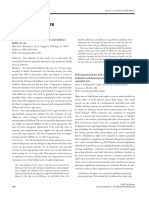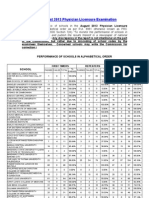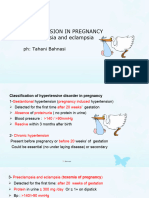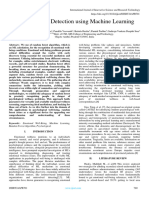Pediatric Health 2011 Report Brief
Pediatric Health 2011 Report Brief
Uploaded by
JayCesarCopyright:
Available Formats
Pediatric Health 2011 Report Brief
Pediatric Health 2011 Report Brief
Uploaded by
JayCesarOriginal Description:
Copyright
Available Formats
Share this document
Did you find this document useful?
Is this content inappropriate?
Copyright:
Available Formats
Pediatric Health 2011 Report Brief
Pediatric Health 2011 Report Brief
Uploaded by
JayCesarCopyright:
Available Formats
REPORTBRIEF APRIL 2011
For more information visit www.iom.edu/childqualitymeasures
Child and Adolescent
Health and Health Care
Quality
Measuring What Matters
Health and health care quality measures can provide valuable information
about the health status of children and adolescents, as well as the outcomes
associated with medical care, policy, and social programs. These measures
are especially useful in monitoring general health and health care trends as
well as identifying disparities among disadvantaged populations. Despite the
fact that the U.S. government currently supports hundreds of data sets and
measures through federal surveys and administrative data systems, the United
States lacks robust national- and state-level information about the health status or health care quality of children and adolescents, particularly in areas
that could provide guidance to policy makers and health care providers.
In the Childrens Health Insurance Program Reauthorization Act of 2009,
Congress directed the Institute of Medicine (IOM) and the National Research
Council (NRC) to evaluate the state of efforts to measure child and adolescent
health and the quality of their health care services. The IOM and the NRC
formed the Committee on Pediatric Health and Health Care Quality Measures,
which reviewed hundreds of population surveys, such as census records and
health surveys, and administrative data sets, such as those based on payment
and health records.
The Nature, Scope, and Quality of Existing Data Sources
Currently, there is no single data source that can provide valid and reliable
indicators about the health and health care quality of children and adolescents. Policy makers and researchers therefore must examine data from a
variety of federal and state data sources to get a clear picture of child and
Currently, there is no single data
source that can provide valid and
reliable indicators about the health
and health care quality of children
and adolescents.
adolescent health and the quality of health care
they receive. The committee concludes that a
lack of standardization in key areassuch as race
and ethnicity, socioeconomic status, primary
language spoken at home, and parental English
proficiencylimits the ability of those who use
data to identify, monitor, and address persistent
health and health care quality disparities among
children and adolescents. Measurement in these
areas is especially important given the growing
ethnic and racial diversity of children and adolescents and the increasing number of children who
live in poverty. The U.S. Department of Health
and Human Services (HHS) should provide leadership to standardize data in key areas, including
developing precise definitions and utilizing consistent data collection methods.
developing measures for children and adolescents.
This approach to measurement will focus on the
needs of the whole child as opposed to individual clinical concerns and will better address the
distinct needs of younger populations, including
their unique patterns of morbidity and mortality,
their dependent status, and their developmental
stages. Measuring transitions of care between
primary care and specialty care also is important,
especially for children with special health care
needs.
Methodological Areas that Deserve
Attention
The committee endorses the use of innovative
measurement practices that can adapt to changing conditions, changing populations, and opportunities for health improvement. This will require
efforts that track key child and adolescent populations over time to ensure that groups with the
greatest risk for poor outcomes are included in
the relevant data sources. To facilitate innovation in measurement, the strengths and limitations of different surveys need to become more
transparent.
In some cases, HHS can link or aggregate
multiple data sourcesconnecting one database
to another, for exampleand therefore reduce the
burden of data collection on individual states, providers, health plans, and households. Longitudinal
studies, which include multiple observations for
the same children/families over time, also would
enrich the quality of indicators. And the capture
of electronic data offers opportunities to enhance
future measurement activity. Such efforts need to
offer protections for privacy and confidentiality.
They also have the potential to capture important state-level policy and community-level characteristics and enable analysis of the variability
and impact of coverage, eligibility, and payment
policies.
Gaps in Measurement Areas
Research shows that physical and social environments (for example, safe neighborhoods or
crowded housing), personal health behaviors, and
social relationships (for example, parent-child
attachment) influence the health status of children and adolescents and their use of health care
services. These contextual factors have significant
effects on the short- and long-term health outcomes of children and adolescents, yet information about them often is lacking in existing data
sets.
Another significant gap is the general absence
of information about the content and quality of
preventive services that are used by children and
adolescents. This information is especially relevant because screening and early interventions
may mitigate serious health disorders later in life.
A life-course approach to measurement is
one new strategy to closing the gaps in measuring
child and adolescent health and health care quality. This approach, which considers how events at
each stage of life influence subsequent health and
health care quality, is particularly important in
500 Fifth Street, NW
Washington, DC 20001
TEL 202.334.2352
FAX 202.334.1412
A life-course approach to measurement is one key strategy to
closing the gaps in measuring child
and adolescent health and health
care quality. This approach, which
considers how events at each stage
of life influence subsequent health
and health care quality, is particularly important in developing measures for children and adolescents.
A Stepwise Approach
3. Create new measures and data sources in
priority areas
The committee recommends a stepwise approach
(see Figure 1) for improving data sources and measures of health and health care quality for children and adolescents. This approach is designed
to stimulate and support collaborative efforts
among federal and state agencies and key stakeholder groups through the following five steps:
4. Improve methods for data collection, reporting, and analysis
5. Improve public and private capacities to use
and report data
This stepwise approach is necessarily continuous and calls for the evaluation of the measurement system itself for transparency, accessibility, timeliness, quality, and feasibility. The entire
approach will be informed by private initiatives
as well as governmentsponsored efforts. This
approach is meant to align existing and future
efforts to measure health and health care qual-
1. Set shared health and health care quality
goals for children and adolescents in the
United States
2. Develop annual reports and standardized
measures for existing data sets of health and
health care quality that can be collected and
used to assess progress toward those goals
Figure 1: A Stepwise Approach to Measuring Health and Health Care Quality for Children and Adolescents
2. Develop annual
reports and
standardized
measures based on
existing data sets
1. Set shared
health and
health care
quality goals
3. Create new
measures and
data sources
Measuring the Performance
of the Measurement System
Transparency
Accessibility
Timeliness
Quality
Feasibility
5. Improve public
and private
capacity to use
and report data
SOURCE: Committee on Pediatric Health and Health Care Quality Measures, 2011
4. Improve data
collection,
reporting, and
analysis
Committee on Pediatric Health and Health Care Quality
Measures
Gordon H. DeFriese (Chair)
Cecil G. Sheps Center for
Health Service Research,
University of North Carolina
Paula A. Braveman
Center on Social Disparities in
Health, University of California,
San Francisco
Claire D. Brindis
R. Lee Institute for Health
Policy Studies, University of
California, San Francisco
Barbara J. Burns
Services Effectiveness
Research Program, Department
of Psychiatry and Behavioral Sciences, Duke University
School of Medicine
Glenn Flores
Department of Pediatrics,
University of Texas
Southwestern Medical Center
Gary L. Freed
Department of Pediatrics,
University of Michigan Health
Systems
Deborah A. Gross
Department of Acute and
Chronic Care, School of
Nursing, The Johns Hopkins
University
Charles J. Homer
National Initiative for Childrens
Healthcare Quality
Kevin B. Johnson
Department of Biomedical
Informatics and Department of
Pediatrics, Vanderbilt
University School of Medicine
ity for children and adolescents. Some improvements to measurement can be made immediately
under the leadership of the Secretary of HHS; others require longer-term consensus-building efforts
among multiple federal agencies.
Genevieve Kenney
The Urban Institute
Conclusion
Marie C. McCormick
Department of Society,
Human Development and
Health, School of Public Health,
Harvard University
Improving health outcomes for children and adolescents is essential to achieving a healthy future
for the nation. A life-course approach to the measurement of health and health care quality, with
new emphasis on the social and behavioral determinants of health and monitoring disparities in health
and health care quality, will deepen understanding
of key opportunities to achieve these outcomes. f
Kathryn M. McDonald
Center for Primary Care and
Outcomes Research, Stanford
University School of Medicine
Michael J. OGrady
Health Policy and Evaluation
Department, National Opinion
Research Corporation at the
University of Chicago
Alan R. Weil
National Academy for State
Health Policy
Alan M. Zaslavsky
Department of Health Care
Policy, Harvard Medical School
Maxine Hayes
State of Washington,
Department of Health
Study Staff
Rosemary Chalk
Study Director
Wendy Keenan
Program Associate
Patti Simon
Program Officer
Julienne Palbusa
Research Assistant
Chelsea Bodnar
Fellow (January to April 2010)
Pamella Atayi
Senior Program Assistant
Yeonwoo Lebovitz
Research Associate (from
November 2010)
Study Sponsors
The Agency for Healthcare Research and Quality
The Centers for Medicare and Medicaid Services
500 Fifth Street, NW
Washington, DC 20001
TEL 202.334.2352
FAX 202.334.1412
Copyright 2011 by the National Academy of Sciences. All rights reserved.
You might also like
- LET Review Prof Education Assessment of LearningDocument32 pagesLET Review Prof Education Assessment of LearningJayCesar100% (4)
- Teaching ProfessionDocument12 pagesTeaching ProfessionAnonymous E2A6hn4U100% (2)
- Allianz Care Plus Brochure Update 19mar2015 FA R3 5Document11 pagesAllianz Care Plus Brochure Update 19mar2015 FA R3 5Leonard Yang0% (1)
- ASHP Best Practices 2015-2016 PDFDocument793 pagesASHP Best Practices 2015-2016 PDFAhmad MakhloufNo ratings yet
- 20.3 Noyes GrosserDocument20 pages20.3 Noyes GrosserRashidah Abd WahidNo ratings yet
- School-Based Health Centers: Cost-Benefit Analysis and Impact On Health Care DisparitiesDocument7 pagesSchool-Based Health Centers: Cost-Benefit Analysis and Impact On Health Care DisparitiesNikolas IGDNo ratings yet
- Pediatric Recent AdvancementDocument2 pagesPediatric Recent AdvancementAnonymous ceYk4p4No ratings yet
- Running Head: SBHC Policy Analysis 1Document17 pagesRunning Head: SBHC Policy Analysis 1api-314835119No ratings yet
- Running Head: PROGRAM DESIGN: Childhood Obesity: Risk Factors & ImplicationsDocument34 pagesRunning Head: PROGRAM DESIGN: Childhood Obesity: Risk Factors & Implicationsapi-338691074No ratings yet
- Healthy Teens Counseling ApproachDocument6 pagesHealthy Teens Counseling ApproachDebbie CharlotteNo ratings yet
- GMT AssignmentDocument4 pagesGMT AssignmentivychisakuloNo ratings yet
- Cib 03 27 2013Document12 pagesCib 03 27 2013setiatypandia22No ratings yet
- Welfare Reform and Child OutcomesDocument18 pagesWelfare Reform and Child OutcomesCasey CosseyNo ratings yet
- Fa18-Fsn-016 Ans A4Document11 pagesFa18-Fsn-016 Ans A4Mehwish MughalNo ratings yet
- Shi 2001Document15 pagesShi 2001pamelwNo ratings yet
- ArticleDocument19 pagesArticleKITTIVONGSAK VONGSUTHEP KEITHNo ratings yet
- IIN RobertRCetal - healthEducationResearch.vol22.No.3Document14 pagesIIN RobertRCetal - healthEducationResearch.vol22.No.3Iniciativa Contra la Desnutrición Infantil - IDINo ratings yet
- Her Ece 011718-1Document18 pagesHer Ece 011718-1kumar hunterNo ratings yet
- A Systematic Review of Pregnancy Prevention Programs For Minority YouthDocument18 pagesA Systematic Review of Pregnancy Prevention Programs For Minority YouthSittie Mariam ManambaNo ratings yet
- Associations of Family-Centered Care With Health Care Outcomes For Children With Special Health Care NeedsDocument13 pagesAssociations of Family-Centered Care With Health Care Outcomes For Children With Special Health Care NeedsAstridNo ratings yet
- Intervention AssignmentDocument14 pagesIntervention Assignmentapi-654150428No ratings yet
- Journal of Health Economics: William N. Evans, Melinda S. Morrill, Stephen T. ParenteDocument17 pagesJournal of Health Economics: William N. Evans, Melinda S. Morrill, Stephen T. ParentemarissaNo ratings yet
- Nutrition Education Literature ReviewDocument5 pagesNutrition Education Literature Revieweldcahvkg100% (1)
- Evidence-Based Public HealthDocument312 pagesEvidence-Based Public HealthBudi Lamaka100% (9)
- Lu 2010Document33 pagesLu 2010Berry BancinNo ratings yet
- 2007 Body Mass Index Measurement in SchoolsDocument21 pages2007 Body Mass Index Measurement in Schoolsperakang00No ratings yet
- PCD 12 E42Document11 pagesPCD 12 E42api-326476970No ratings yet
- Using The Data Information Knowledge Wisdom ContinuumDocument6 pagesUsing The Data Information Knowledge Wisdom ContinuumLori A. Dixon67% (6)
- Time. A Guide For School-Level Implementation of Wellness Policies & PracticesDocument10 pagesTime. A Guide For School-Level Implementation of Wellness Policies & Practicesapi-320307298No ratings yet
- For You, LuvotDocument13 pagesFor You, Luvotlalove aespaNo ratings yet
- Teen Pregnancy Group PaperDocument7 pagesTeen Pregnancy Group Paperapi-259018499No ratings yet
- Research TitilDocument6 pagesResearch Titilhaimanotgedlu11No ratings yet
- Part II 4. Primary Secondary and Tertiary Prevention Strategies in Public HealthDocument27 pagesPart II 4. Primary Secondary and Tertiary Prevention Strategies in Public HealthDodi MulyadiNo ratings yet
- Press Release 12-09 - New Study Raises Health and Safety Concerns inDocument3 pagesPress Release 12-09 - New Study Raises Health and Safety Concerns inhealthoregonNo ratings yet
- What Reasonably Expect?: The Contribution of School Health Education Community Health Promotion: CanDocument8 pagesWhat Reasonably Expect?: The Contribution of School Health Education Community Health Promotion: CansapiokaravoNo ratings yet
- Clinical Preventive Services For Adolescents:: Position Paper of The Society For Adolescent MedicineDocument12 pagesClinical Preventive Services For Adolescents:: Position Paper of The Society For Adolescent MedicineManjeev GuragainNo ratings yet
- Literature Review Obesity ChildhoodDocument8 pagesLiterature Review Obesity Childhoodafdttjujo100% (1)
- 1ausing Information Systems To Improve Population Outcomes Concepts in Program Design and Development Structure SystemsDocument7 pages1ausing Information Systems To Improve Population Outcomes Concepts in Program Design and Development Structure Systemsapi-678571963No ratings yet
- Patient A Besoin SpecifiqueDocument12 pagesPatient A Besoin Specifiquefz.elgasmi.fzNo ratings yet
- The Teen Pregnancy Prevention Program: An Evidence-Based Public Health Program ModelDocument2 pagesThe Teen Pregnancy Prevention Program: An Evidence-Based Public Health Program ModelGenesis FaderogaoNo ratings yet
- Paper JICDocument28 pagesPaper JICHeber LopezNo ratings yet
- Exploring The Science of Complementary and Alternative MedicineDocument68 pagesExploring The Science of Complementary and Alternative MedicineAurutchat VichaiditNo ratings yet
- A Review of Literature On Access To Primary Health CareDocument5 pagesA Review of Literature On Access To Primary Health CareafmzsbzbczhtbdNo ratings yet
- Expert and Stakeholder Consensus On Priorities For Obesity Prevention Research in Early Care and Education SettingsDocument10 pagesExpert and Stakeholder Consensus On Priorities For Obesity Prevention Research in Early Care and Education Settingsparanoea911No ratings yet
- YBRSS - Lake County Final HA Report 8-13-14Document47 pagesYBRSS - Lake County Final HA Report 8-13-14The News-HeraldNo ratings yet
- Literature Review Childhood ObesityDocument4 pagesLiterature Review Childhood Obesityc5j07dce100% (1)
- Determinants of Pediatric Care Utilization : Ann D. ColleDocument44 pagesDeterminants of Pediatric Care Utilization : Ann D. CollejuanelgaNo ratings yet
- Health Care Changes For Children With Special Health CareDocument8 pagesHealth Care Changes For Children With Special Health CareexaNo ratings yet
- 003Document15 pages003TMRNo ratings yet
- Thesis - Henriikka Laurola PDFDocument136 pagesThesis - Henriikka Laurola PDFdekth LibunaoNo ratings yet
- Research Paper Topics On Child WelfareDocument11 pagesResearch Paper Topics On Child Welfarefvfr9cg8100% (1)
- Magellan Grant ProposalDocument14 pagesMagellan Grant Proposalapi-455495242No ratings yet
- Public Health TerminologyDocument17 pagesPublic Health Terminologymohammed RAFINo ratings yet
- Example Literature Review On Childhood ObesityDocument6 pagesExample Literature Review On Childhood Obesityc5praq5p100% (1)
- ObesityDocument14 pagesObesityapi-338453738No ratings yet
- Research Paper Health PolicyDocument7 pagesResearch Paper Health PolicyuzypvhhkfNo ratings yet
- Review Article: Need For Early Interventions in The Prevention of Pediatric Overweight: A Review and Upcoming DirectionsDocument18 pagesReview Article: Need For Early Interventions in The Prevention of Pediatric Overweight: A Review and Upcoming DirectionsIsabel ReyNo ratings yet
- Review 2008 enDocument6 pagesReview 2008 envimlenNo ratings yet
- Health Literacy Among Older Adults A Systematic Literature ReviewDocument4 pagesHealth Literacy Among Older Adults A Systematic Literature ReviewcmaqqsrifNo ratings yet
- Ermias StastisticianDocument30 pagesErmias StastisticianQaroo HabtamuNo ratings yet
- 1 s2.0 S1049386713001060 MainDocument10 pages1 s2.0 S1049386713001060 Mainannisa.indriyaniNo ratings yet
- Dr. Catherine W. Kisavi-Atatah (PH.D.), Dr. Park E. Atatah (PH.D.), Dr. Angela Branch-Vital (PH.D.)Document20 pagesDr. Catherine W. Kisavi-Atatah (PH.D.), Dr. Park E. Atatah (PH.D.), Dr. Angela Branch-Vital (PH.D.)Ijahss JournalNo ratings yet
- Caregiving MonographDocument60 pagesCaregiving MonographZekel HealthcareNo ratings yet
- Quality of Good Teach e 2Document24 pagesQuality of Good Teach e 2JayCesarNo ratings yet
- Read This... Pls.. NLE 1Document16 pagesRead This... Pls.. NLE 1JayCesarNo ratings yet
- 1 Finalto: Bicol State College of Applied Sciences and Technology City of Naga College of EducationDocument60 pages1 Finalto: Bicol State College of Applied Sciences and Technology City of Naga College of EducationJayCesarNo ratings yet
- Teaching Profession1Document4 pagesTeaching Profession1JayCesarNo ratings yet
- LeadershipDocument13 pagesLeadershipJayCesarNo ratings yet
- Reaction Paper: Teaching ProfessionDocument5 pagesReaction Paper: Teaching ProfessionJayCesarNo ratings yet
- PrincipleofTeaching NotesDocument23 pagesPrincipleofTeaching NotesJayCesar100% (1)
- Reaction Paper: Teaching ProfessionDocument5 pagesReaction Paper: Teaching ProfessionJayCesarNo ratings yet
- Lesson Plan Principles OF TeachingDocument4 pagesLesson Plan Principles OF TeachingJayCesarNo ratings yet
- The Drainage: Basahin Mo Yan Rhandy Pang Top Board 2 Dali.. Dali Mo Na Dali. Kakatamad Basahin... NLE CgenaDocument13 pagesThe Drainage: Basahin Mo Yan Rhandy Pang Top Board 2 Dali.. Dali Mo Na Dali. Kakatamad Basahin... NLE CgenaJayCesarNo ratings yet
- Principles of Teaching AgnoDocument9 pagesPrinciples of Teaching AgnoJayCesar0% (1)
- Ito... Final Teaching Demo: Lesson Plan Principles OF TeachingDocument4 pagesIto... Final Teaching Demo: Lesson Plan Principles OF TeachingJayCesarNo ratings yet
- Lesson Plan Principles OF TeachingDocument4 pagesLesson Plan Principles OF TeachingJayCesarNo ratings yet
- The Drainage: Basahin Mo Yan Rhandy Pang Top Board 2 Dali.. Dali Mo Na Dali. Kakatamad Basahin... NLE CgenaDocument13 pagesThe Drainage: Basahin Mo Yan Rhandy Pang Top Board 2 Dali.. Dali Mo Na Dali. Kakatamad Basahin... NLE CgenaJayCesarNo ratings yet
- Lesson Plan in Biology Second Year High SchoolDocument3 pagesLesson Plan in Biology Second Year High SchoolJayCesarNo ratings yet
- Nursing Practice Threeso 1Document16 pagesNursing Practice Threeso 1JayCesarNo ratings yet
- Nursing Practice Threesoko Na Ito Cgena... Kainis 1Document16 pagesNursing Practice Threesoko Na Ito Cgena... Kainis 1JayCesarNo ratings yet
- Hospital Hazards PresentationDocument30 pagesHospital Hazards Presentationkhizgaming world100% (1)
- Asma 2018Document3 pagesAsma 2018gheaNo ratings yet
- Tourism Final ProjectDocument88 pagesTourism Final ProjectPrajwal AlvaNo ratings yet
- Medonic M Series Hematology Analyzer Service ManualDocument4 pagesMedonic M Series Hematology Analyzer Service ManualIvan de la Rosa50% (2)
- Healthcare Logistics Optimization Framework For EfDocument13 pagesHealthcare Logistics Optimization Framework For EfBbb AaaNo ratings yet
- Manifesto: Admin Reforms - Transparency & AccountabilityDocument2 pagesManifesto: Admin Reforms - Transparency & AccountabilityanshulNo ratings yet
- Antenatal ExercisesDocument11 pagesAntenatal ExercisesRashmi C S0% (1)
- Nursing Practice 1Document16 pagesNursing Practice 1HailMarieSBarcenas100% (1)
- Autogenic TrainingDocument5 pagesAutogenic Trainingking.fahmie23100% (1)
- CamaristaCM - Nursing Care PlanDocument3 pagesCamaristaCM - Nursing Care PlanColeen Mae CamaristaNo ratings yet
- NURS FPX 6410 Assessment 3 Exploration of Regulations and Implications For PracticeDocument5 pagesNURS FPX 6410 Assessment 3 Exploration of Regulations and Implications For Practicejoohnsmith070No ratings yet
- Policy ImplementationDocument4 pagesPolicy ImplementationAlyssa Mariae CodornizNo ratings yet
- Christine LFDDocument11 pagesChristine LFDAmari BillNo ratings yet
- Legal and Ethical AspectsDocument46 pagesLegal and Ethical AspectsSanjay Kumar SanjuNo ratings yet
- Eng 1010 Final Informative Research Paper 2Document7 pagesEng 1010 Final Informative Research Paper 2api-317626858No ratings yet
- Performance of Schools in The August 2013 Physician Licensure ExaminationDocument2 pagesPerformance of Schools in The August 2013 Physician Licensure ExaminationSunStar Philippine NewsNo ratings yet
- 3h CompDocument4 pages3h CompCzara DyNo ratings yet
- Europass Curriculum Vitae: Personal InformationDocument7 pagesEuropass Curriculum Vitae: Personal InformationAndrei TudoracheNo ratings yet
- Patient-Related Case Studies in Medicinal ChemistryDocument5 pagesPatient-Related Case Studies in Medicinal ChemistryEduardo Damasceno CostaNo ratings yet
- Preeclampsia and Eclampsia-1Document26 pagesPreeclampsia and Eclampsia-1Mohamed AdelNo ratings yet
- Mental Health Detection Using Machine LearningDocument7 pagesMental Health Detection Using Machine LearningInternational Journal of Innovative Science and Research TechnologyNo ratings yet
- BR J Haematol - 2020 - McNamara - The Investigation and Management of Follicular LymphomaDocument19 pagesBR J Haematol - 2020 - McNamara - The Investigation and Management of Follicular LymphomaFamilia Macovei Haralambie-AndreeaNo ratings yet
- الامتحان النهائي السريري طب الطوارئDocument8 pagesالامتحان النهائي السريري طب الطوارئAhmedNo ratings yet
- Edn Quiz 1 - A2: Questions 1 To 10Document5 pagesEdn Quiz 1 - A2: Questions 1 To 10Je KirsteneNo ratings yet
- Critical Incident EssayDocument2 pagesCritical Incident Essayapi-314200814No ratings yet
- Techno. Week 2Document2 pagesTechno. Week 2Yian AmadNo ratings yet
- Adrienne Bacon ResumeDocument2 pagesAdrienne Bacon Resumeapi-272550174No ratings yet
- Dated:: Anatomy AreDocument8 pagesDated:: Anatomy Arepriya swathiNo ratings yet






































